德国标准DIN 4102建筑材料防火性能要求和测试分类等级
建筑材料燃烧性能分级及检测方法解析

我《建筑材料燃烧性能分级》(首次颁布)
参考西德标准DIN4102-1:1981《建筑材料和构件的火 灾特性 第1部分:建筑材料的分级要求和试验》
GB8624-1997《建筑材料燃烧性能分级方法》
修改采用EN13501-1:2002《建筑制品和构件的火灾 分级 第1部分:用对火反应试验数据的分级》
• 复合材料、表面涂层材料
1、对定型生产的复合型建筑材料,不论其厚度如何,也不管以何种工艺生产, 均应以定型产品进行燃烧特性检验,并对其进行综合评价。 2、对在现场以喷涂、粘贴或其他方法附加于内装饰基材表面的涂层或其他饰 面层(如壁纸),其厚度≤0.6mm 或单位面积质量≤300g/m2, 可不考虑饰 面层对其基材燃烧特性及分级的影响。若饰面层厚度超过0.6mm 或饰面对 基材燃烧特性有明显影响时, 应将饰面连同基材一并制取成试样进行试验 ,作出整体综合评价。 3、对表面进行防火处理的材料,其燃烧性能分级应以处理后的材料进行试验
欧洲 法国 英国 德国 欧盟颁布统一的分级标准前
分为M0、M1、M2、M3、M4和M5六个等级
分为不燃和可燃的0、1、2、3、4级
分为A1、A2、B1、B2和B3五个等级
欧盟颁布统一的分级标准后
GB8624-1997
EN 13501-1:2002 《 建筑制品和构件的火灾分级 第一部分: 用对火反应试验数据的分级 》 GB86242006 材料燃烧性能分为A1、A2、B、C、D、E、和F七个等级 材料燃烧性能分为A(A1,A2) ,B1(B,C),B2(D,E),B3(F)四个等 级——(GB 8624-2012)
第三部分 燃烧性能分级及评判标准
• GB8624-1997 分级及评判标准
• GB8624-2006 分级及评判标准
各国不同防火阻燃性纺织品的评价标准
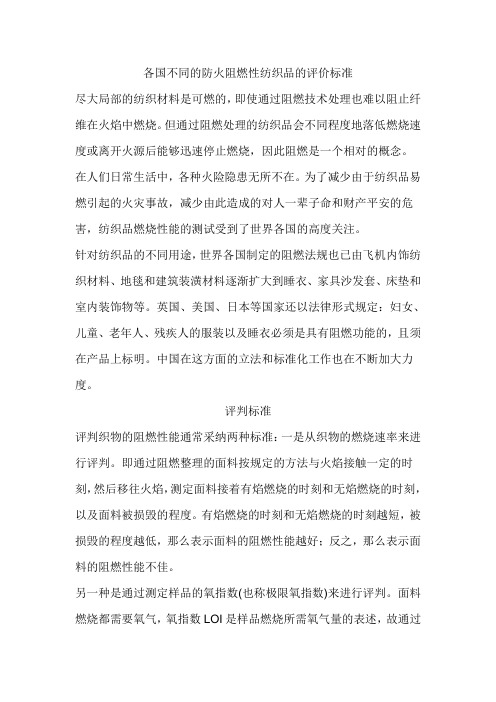
各国不同的防火阻燃性纺织品的评价标准尽大局部的纺织材料是可燃的,即使通过阻燃技术处理也难以阻止纤维在火焰中燃烧。
但通过阻燃处理的纺织品会不同程度地落低燃烧速度或离开火源后能够迅速停止燃烧,因此阻燃是一个相对的概念。
在人们日常生活中,各种火险隐患无所不在。
为了减少由于纺织品易燃引起的火灾事故,减少由此造成的对人一辈子命和财产平安的危害,纺织品燃烧性能的测试受到了世界各国的高度关注。
针对纺织品的不同用途,世界各国制定的阻燃法规也已由飞机内饰纺织材料、地毯和建筑装潢材料逐渐扩大到睡衣、家具沙发套、床垫和室内装饰物等。
英国、美国、日本等国家还以法律形式规定:妇女、儿童、老年人、残疾人的服装以及睡衣必须是具有阻燃功能的,且须在产品上标明。
中国在这方面的立法和标准化工作也在不断加大力度。
评判标准评判织物的阻燃性能通常采纳两种标准:一是从织物的燃烧速率来进行评判。
即通过阻燃整理的面料按规定的方法与火焰接触一定的时刻,然后移往火焰,测定面料接着有焰燃烧的时刻和无焰燃烧的时刻,以及面料被损毁的程度。
有焰燃烧的时刻和无焰燃烧的时刻越短,被损毁的程度越低,那么表示面料的阻燃性能越好;反之,那么表示面料的阻燃性能不佳。
另一种是通过测定样品的氧指数(也称极限氧指数)来进行评判。
面料燃烧都需要氧气,氧指数LOI是样品燃烧所需氧气量的表述,故通过测定氧指数即可判定面料的阻燃性能。
氧指数越高那么讲明维持燃烧所需的氧气浓度越高,即表示越难燃烧。
该指数可用样品在氮、氧混合气体中维持烛状燃烧所需氧气的最小体积百分数来表示。
从理论上讲,纺织材料的氧指数只要大于21%(自然界空气中氧气的体积浓度),其在空气中就有自熄性。
依据氧指数的大小,通常将纺织品分为易燃(LOI<20%)、可燃(LOI=20%~26%)、难燃(LOI=26%~34%)和不燃(LOI>35%)四个等级。
事实上,几乎所有常规纺织材料(纤维)都属易燃或可燃的范围。
DIN 4102-1-1998材和构件的耐燃性.第1部分建材.概念、 要求和 检验

ICS 13.220.50; 91.100.01Descriptors:Fire behaviour, building materials, components,elements, classification.Brandverhalten von Baustoffen und Bauteilen – Teil 1:Baustoffe –Begriffe, Anforderungen und Prüfungen In keeping with current practice in standards published by the International Organization for Standardization (ISO), a comma has been used throughout as the decimal marker.ContentsRef.No.DIN 4102-1:1998-05English price group 13Sales No.011306.99DEUTSCHE NORM May 19984102-1{Continued on pages 2 to 33.©No part of this translation may be reproduced without the prior permission ofDIN Deutsches Institut für Normung e.V., Berlin.Beuth Verlag GmbH , D-10772Berlin, has the exclusive right of sale for German Standards (DIN-Normen).Translation by DIN-Sprachendienst.In case of doubt, the German-language original should be consulted as the authoritative text.Fire behaviour of building materials and elementsPart 1:Classification of building materialsRequirements and testingSupersedes May 1981 edition.Page Foreword . . . . . . . . . . . . . . . . . . . . . . . . . . . . . . . 21Scope . . . . . . . . . . . . . . . . . . . . . . . . . . . . . . . 22Normative references . . . . . . . . . . . . . . . . . 23Building material classes . . . . . . . . . . . . . . 34Classifying building materials . . . . . . . . . . 34.1Materials requiring testing . . . . . . . . . . . . . 34.2Materials not requiring testing . . . . . . . . . 35Class A building materials . . . . . . . . . . . . .35.1Class A1 materials . . . . . . . . . . . . . . . . . . .35.1.1General requirements . . . . . . . . . . . . . . .35.1.2Criteria for classification . . . . . . . . . . . . .35.1.3Furnace test . . . . . . . . . . . . . . . . . . . . . . .45.1.4Evaluation of furnace test results . . . . . .65.1.5Test certificate . . . . . . . . . . . . . . . . . . . . .75.2Class A2 materials . . . . . . . . . . . . . . . . . . .75.2.1General requirements . . . . . . . . . . . . . . .75.2.2Criteria for classification . . . . . . . . . . . . .75.2.3Testing . . . . . . . . . . . . . . . . . . . . . . . . . . .85.2.4Additional requirements for specificmaterials . . . . . . . . . . . . . . . . . . . . . . . . . .85.2.5Test certificate . . . . . . . . . . . . . . . . . . . . . 10Page6Class B building materials . . . . . . . . . . . . . 106.1Class B1 materials . . . . . . . . . . . . . . . . . . . 106.1.1General requirements . . . . . . . . . . . . . . . 106.1.2Criteria for classification . . . . . . . . . . . . . 116.1.3Testing . . . . . . . . . . . . . . . . . . . . . . . . . . . 116.1.4Test certificate . . . . . . . . . . . . . . . . . . . . . 116.2Class B2 materials . . . . . . . . . . . . . . . . . . . 126.2.1General requirements . . . . . . . . . . . . . . . 126.2.2Criteria for classification . . . . . . . . . . . . . 126.2.3Ignitibility test: Specimens . . . . . . . . . . . 126.2.4Ignitibility test: Apparatus . . . . . . . . . . . . 136.2.5Ignitibility test: Procedure . . . . . . . . . . . . 136.2.6Test for molten dripping . . . . . . . . . . . . . 136.2.7Test certificate . . . . . . . . . . . . . . . . . . . . . 136.3Class B3 materials . . . . . . . . . . . . . . . . . . . 167Marking . . . . . . . . . . . . . . . . . . . . . . . . . . . . . 17Appendix A:Smoke generation test –Decomposition method . . . . . . . 17Appendix B:Smoke generation test –Flame impingement method . . . 23Appendix C:Smoke toxicity testing of class A materials . . . . . . . . . . . . 30Explanatory notes . . . . . . . . . . . . . . . . . . . . . . . 33Page2DIN4102-1:1998-05ForewordThis standard has been prepared by Technical Committee Bra ndverha lten von Ba ustoffen of the Normen-ausschuß Bauwesen (Building and Civil Engineering Standards Committee).AmendmentsThe following amendments have been made to the May 1981 edition.a)Additional requirements are specified for material classes A2 and B1.b)Smoke generation tests and toxicity tests are now included.c)The fire test using the ‘Brandschacht’ apparatus is no longer included as it is now specified in DIN4102-16.Previous editionsDIN4102-1:1977-09, 1981-05.Dimensions in mm1Scope1.1This standard defines fire behaviour classes for building materials and specifies requirements and test methods for each class. It applies to sheet materials (including plates and slabs), composite materials, material assemblies, coverings, insulation, coatings, pipes and fittings, decorative materials, curtains and other mate-rials suspended from ceilings, fire retardants, and intumescent coatings, whether or not these materials are designated as construction products (‘Bauprodukte’) in the German Länder building regulations (cf. Explana-tory notes).1.2The classification specified in this standard serves to assess the fire behaviour of materials alone or in combination. Fire behaviour not only depends on the nature of the material, but also on its shape, surface characteristics, density, processing, and its combination with other materials, including any bonding agents or fasteners used. These factors are to be taken into account when preparing tests, selecting specimens, evalu-ating test results and marking the materials.2Normative referencesThis standard incorporates, by dated or undated reference, provisions from other publications. These norma-tive references are cited at the appropriate place in the text and the titles of the publications are listed below. For dated references, subsequent amendments to or revisions of any of these publications apply to this standard only when incorporated into it by amendment or revision. For undated references, the latest edition of the publication referred to applies.DIN4102-2Fire behaviour of building materials and elements – Building components – Concepts, require-ments and testsDIN4102-4Fire behaviour of building materials and elements – Overview and design of classified building materials, elements and componentsDIN4102-8Fire behaviour of building materials and elements – Small-scale test furnaceDIN4102-14Fire behaviour of building materials and elements – Determination of the burning behaviour of floor covering systems using a radiant heat sourceDIN4102-15Fire behaviour of building materials and elements – ‘Brandschacht’ apparatusDIN4102-16Fire behaviour of building materials and elements – ‘Brandschacht’ testsDIN18180Gypsum plasterboard – Types, requirements and testingDIN50014Artificial climates in technical applications – Standard atmospheresDIN50050-1Small cabinets for testing the burning behaviour of materialsDIN50051Burners for testing the burning behaviour of materialsDIN50055Light measuring system for testing smoke developmentDIN51622Propane, propene, butane, butene and their mixtures – RequirementsDIN51900-2Determination of gross calorific value of solid and liquid fuels using the bomb calorimeter, and calculation of calorific value – Method using the isothermal jacketDIN51900-3Determination of gross calorific value of solid and liquid fuels using the bomb calorimeter, and calculation of calorific value – Method using the adiabatic jacketDIN53436-1Toxicity testing of fire effluents – Combustion apparatus and determination of test temperature DIN53436-2Toxicity testing of fire effluents – Thermal decomposition methodPage 3DIN4102-1:1998-05DIN53436-3Toxicity testing of fire effluents – Method of testing inhalation toxicityDIN53438-1Determining the response of combustible materials to ignition by a small flame – General DIN66081Classification of the burning behaviour of textile products – Textile floor coveringsISO1716:1973Building materials – Determination of calorific potentialISO4783-2:1989Industrial wire screens and woven wire cloth – Guide to the choice of aperture size and wire diameter combinations – Part2:Preferred combinations for woven wire cloth3Building material classesBuilding materials shall be classed according to their fire behaviour as shown in table1.Table1:Building material classesBuilding material class Designation*)A Non-combustible materials (‘nichtbrennbar’)A1A2B Combustible materials (‘brennbar’)B1Not easily flammable (‘schwerentflammbar’)B2Flammable (‘normalentflammbar’)B3Easily flammable (‘leichtentflammbar’)*)Translator’s note. The German terms given are those used in Germanbuilding regulations.These symbols and designations may only be used if the material’s fire behaviour has been determined in accordance with this standard (cf. clause4).4Classifying building materials4.1Materials requiring testingThe class of most building materials shall be determined on the basis of the fire tests specified in this standard. Materials which are designated as building products in the German Länder building regulations and which meet the general requirements of this standard for the relevant class still require additional proof1) when –the results of testing as in this standard are not alone sufficient for classification (cf. subclauses 5.1.2.1,5.2.2.1 and6.1.2.1), or–additional testing using other methods is required for classification.4.2Materials not requiring testingThe building materials covered by DIN4102-4 shall be classed as specified therein without further testing.5Class A building materials5.1Class A1 materials5.1.1General requirementsThe test specified in subclause5.1.3 provides a fire model describing the growth and full development phases of a fire. During these phases, class A1 materials shall not release any ignitable gases or any considerable amount of heat.5.1.2Criteria for classification5.1.2.1Materials may be classed as A1 materials if they–pass the test specified in subclause 5.1.3 and–meet the requirements for class A2 materials (testing is not necessary here if it is evident beyond any doubt that these requirements are fulfilled).1)According to German building regulations, such materials either require general approval by the buildinginspectorate in the form of an agrément, or their suitability is to be verified on a case-by-case basis.Page4DIN4102-1:1998-05The tests specified in this standard are not sufficient for assessing materials which are to meet additional requirements regarding the release of toxic gases; additional testing is required in this case.2)5.1.2.2The test specified in subclause 5.1.3 shall be deemed passed if–no flaming occurs (cf. subclause 5.1.4);–none of the specimens releases enough heat to cause the temperature in the furnace to rise by more than 50°C above the initial temperature.5.1.3Furnace test5.1.3.1Number and size of specimensFive 40mm×40mm×50mm specimens shall be tested (see figure2 for tolerances).The specimens shall be representative of the material. Specimens of materials delivered with a thickness less than 40 mm shall consist of several layers; in this case, each layer shall be cut to a length of 40mm and a height of 50mm, and thinned down, if necessary, so that the total thickness is 40mm.The thickness of compressible materials shall be that obtained under a load of 0,1kN/m2 per unit area.For materials containing varying quantities of combustible components (e.g. binders), the component with the highest combustibility shall be tested. For components with a lower combustibility, it is sufficient to determine their quantity only (e.g. by checking ignition loss).5.1.3.2Coated materialsCoatings applied at the works are to be tested along with the coated material.If both the material and its coating are to meet the requirements for class A1, the coating thickness on test specimens shall be as in service.1Pilot flame2Mid-height plane of refractory tube3Heating coils4Aluminium oxide powder5Specimen6Thermocouple7Nine holes (of 3mm diameter)Figure1:Electric furnace2)Appendix C specifies a toxicity test but not any requirements.Page 5DIN 4102-1:1998-05Figure 2:Placing multi-layer specimens in heating tube5.1.3.3Specimen preparationDry specimens at 105°C for six hours and store them in a desiccator above anhydrous calcium chloride or silica gel until they are required for testing.For multi-layer specimens, place the least favourable surfaces in terms of fire behaviour facing outward, as shown in figure 2. Then, tie the specimen with a temperature-resistant wire (e.g. of NiCr) having a 0,2mm diameter, binding the specimen in the middle so that the layers are held firmly together. Cut surfaces are not to face outwards (cf. figure 2).Place tied specimens in a wire holder weighing (5t 0,5)g; this will help keep the specimen in the same position.Place specimens which may disintegrate during testing or which are of loose material in a basket of stainless steel wire mesh having an aperture size of 1mm and wire diameter of 0,5mm as in ISO 4783-2.Specimens which could run out of the wire basket during testing are to be placed in a container of nickel sheet that is 0,2mm thick.5.1.3.4Apparatus and procedureApparatusTesting is to be carried out in an electrically heated furnace 3) with heating coils arranged along the circumfer-ence of the refractory tube.To minimize temperature fluctuations in the furnace, the supply voltage is to be kept constant to within t 0,5%by means of a voltage stabilizer.3)Information on sources of supply is available from the Normenausschuß Bauwesen of DIN, D-10772 Berlin.1Uncut layer 2Surface which is least favourable in terms of fire behaviour 3Surface which is most favourable in terms of fire behaviour 4Cut-down layer 5Cut surface 6Binding wire 7Thermocouple in heating tube 8Centre plane of furnaceNOTE: The specimen holder is not shown. The layersare to be in close contact with one another. A gapis shown merely to illustrate the arrangementmore clearly.Wire should be used to bind the layers firmlytogether.Page6DIN4102-1:1998-05To measure the temperature inside the furnace, insert a thermocouple reaching down to the centre of the heating tube (cf. figure1) at a distance of (10t0,5) mm from the tube wall. The thermocouple shall be made of a 0,5mm thick wire with an open junction; sheathed thermocouples with an appropriate response charac-teristic may also be used.The temperature indicator shall have a limit of error no greater than 5°C.A pilot flame of propane gas as in DIN51622 is to be located (20t1) mm above the centre of the heating tube’s top opening.To observe the specimen during testing, place a slanted mirror above the furnace.ProcedurePre-heat the furnace to (750t10)°C; this temperature is to remain constant to within t1°C without needing readjustment for at least ten minutes before testing. The energy input to the heating element is to remain constant throughout the test.Suspend the specimen in the heating tube so that its centre is level with the junction of the thermocouple. The original specimen surface, or – in the case of asymmetrical specimens – the least favourable surface in terms of fire behaviour is to face the thermocouple, which shall be located midway across this surface’s width (cf. figure2).Multi-layered specimens are to be suspended as shown in figure2.When suspending the specimen, do not open the furnace cover for more than five seconds.The test period begins when the bottom edge of the specimen passes the top edge of the heating tube. Leave the specimen in the furnace until the maximum furnace temperature has been reached, and for at least 15minutes.If the initial furnace temperature has still not risen after 30minutes, only one specimen needs to be tested to the point where the maximum temperature is reached (but for no longer than 90minutes), provided the other specimens behave in a similar manner during the first 30minutes.If the pilot flame is extinguished by gases released by the specimen, an immediate attempt shall be made to relight it with a burner that produces a gas flame about 20mm long. If the first attempt fails, further attempts shall be made every 15seconds.The furnace cover shall not be opened during the test. The holes in the bottom plate are to be cleared before each test.5.1.4Evaluation of furnace test resultsFlaming has occurred ifa)flames can be observed in the furnace, orb)there is glowing combustion (incandescence does not necessarily indicate combustion), orc)the pilot flame enlarges to a height greater than 45 mm, or expands horizontally to fill the furnace coveropening (see figure3).No flaming occurs Flaming occurs Flaming occurs1Flame enlargement2Original pilot flameFigure3:Examples for assessing pilot flame enlargement to determinewhether flaming has occurredPage 7DIN 4102-1:1998-05For 2), see page 4.4)According to the German building regulations, this test certificate serves as a basis for the verification of conformity, ‘Übereinstimmungsnachweis ’ (for regulated products) or as proof of suitability, ‘Verwendbar-keitsnachweis ’ (for non-regulated products). See Explanatory notes.5.1.5Test certificateIf a building material can be classed as an A1 material on the basis of testing as in this standard, a test certificate 4) stating this shall be prepared which shall contain the following information:a) a full description of the building material, including its type (e.g. main constituents), appearance, design,dimensions, density or mass per unit area, and sampling method used;b)preparation and mounting of specimens, test procedure, number of tests;c)for each specimen, the duration of flaming;d)for each specimen, the results of furnace testing (expressed as the maximum increase in temperature);e)any observations made during testing (e.g. enlargement or extinction of pilot flame, appearance of specimen after the test);f)classification as a class A1 material;g)period of validity (no more than five years; extensions may be granted upon request).For materials which cannot be classified solely on the basis of this standard (cf. subclause 4.1), a test report shall be prepared that does not include any information regarding classification.5.2Class A2 materials5.2.1General requirementsThe fire tests specified in subclause 5.2.3 provide a fire model describing the growth and full development phases of a fire. During these phases, the heat release and spread of fire shall be minimal, the release of any ignitable gases limited, and any generation of smoke shall not be hazardous to health.5.2.2Criteria for classification5.2.2.1Materials may be classed as A2 materials if they withstand–the test specified in subclause 5.1.3 or the tests specified in subclauses 5.2.3.2 and 5.2.3.3, and –the test specified DIN 4102-16, and–the test specified in subclause 5.2.3.5.For composite materials with combustible layers making up more than 20% either of the total mass or total volume (whichever is greater), the results of testing as in this standard are not sufficient for classification. For instance, a composite material containing a layer of combustible insulation cannot be classified as an A2material if the requirements for the net calorific value are met only when a non-combustible cover layer is provided.The test methods specified in this standard are not inadequate for assessing materials which are to meet additional requirements regarding the release of toxic gases; additional testing is required in this case.2)5.2.2.2The furnace test shall be deemed passed if, after 15 minutes of testing as in subclause 5.1.3, the requirements specified in subclause 5.1.2.2 are met, except that sustained flaming for a total period of 20sec-onds is permitted as long as the flames on the specimen do not extend beyond the heating tube and the pilot flame is not enlarged to a height greater than 100mm.The sum of all periods of observed flaming of one second or longer shall be taken as the total period of sustained flaming. Where flaming occurs simultaneously at different places, any overlapping of periods shall be disre-garded so that the total period is counted as one continuous length of time (cf. subclause 5.1.4).5.2.2.3The requirement for the net calorific value, H u , shall be deemed to have been met if this value is no greater than 4200kW ës/kg when testing as in subclause 5.2.3.2. If the gross calorific value, H o , is less than 4200kW ës/kg, then H u need not be determined.5.2.2.4The test specified in subclause 5.2.3.3 shall be deemed passed if the heat release calculated on the basis of H u and the specimen’s mass per unit area before and after the test is not greater than 16800 kW ës/m 2.If the value calculated before testing for the material in its as-delivered condition is less than 16800 kW ës/m 2,then testing as in 5.2.3.3 is not necessary.5.2.2.5The test using the ‘Brandschacht’ apparatus (cf. subclause6.1.3) shall be deemed passed if–the mean value for the residual length (portion of specimen that has not burned or charred; cf. subclause 9.1of DIN 4102-16) of each specimen is at least 35 cm and no individual values are lower than 20cm,Page 8DIN 4102-1:1998-05–the mean effluent temperature does not exceed 125°C in any test,–there is no flaming on the back of any specimen,–the requirement for the residual length of each specimen is met even where there is afterflame, afterglow,or smouldering,–flames do not reach above the top surface of the specimen, and–there is no molten dripping.5.2.2.6The test specified in subclause 5.2.3.5 shall be deemed passed if the effluents produced by decom-position (when testing as in Appendix A) and those produced by flame impingement (when testing as in Appendix B) are deemed to be harmless. This is the case if–when testing as in Appendix A, the mean light absorptance does not exceed 30% at any smoulder temperature, and–when testing as in Appendix B, the maximum mean absorptance without a supply of air is not greater than 15% (cf. table B.3). If this value is exceeded, additional testing may be required (cf. subclause 4.1).5.2.3Testing5.2.3.1Furnace testThe furnace test shall be carried out as specified in subclause 5.1.3.5.2.3.2Net calorific value determinationThe net calorific value, H u , shall be determined as in DIN 51900-2 or DIN 51900-3, although specimens shall be prepared as in ISO 1716.5.2.3.3Heat release testAt least two 500mm ×500mm specimens having a thickness as used in service shall be tested. Prior to testing,they shall be conditioned in a DIN 50014-23/50-2 standard atmosphere until they reach constant mass.Testing shall be carried out using a small-scale test furnace as in DIN 4102-8. The specimens, which are to be backed with a 20mm thick calcium silicate slab having an apparent density of (850t 50)kg/m 3, shall be fixed in the side openings of the furnace so that one surface is facing the fire chamber. In the case of asymmetrical specimens, one test shall be performed on each side. The points at which the specimen is fixed to the furnace are to be carefully sealed.The fire chamber is to be exposed to flame (i.e. heated) as specified in subclause 6.2.4 of DIN 4102-2 for a period of 30minutes. At the end of this period, cut a piece (having an area of about 100cm 2 and the same thickness as the rest of the specimen) from the centre of the specimen, and determine its mass per unit area and net calorific value as specified in DIN 51900-2 or DIN 51900-3.5.2.3.4‘Brandschacht’ testingTesting shall be as in DIN 4102-16 using the ‘Brandschacht’ apparatus specified in DIN 4102-15 (except for floor coverings, which shall be tested as in subclause 6.1.3.2).5.2.3.5Smoke generation testTesting shall be as specified in Appendices A and B, taking the following into consideration:a)Coatings shall be applied to a plate having a thickness of 0,88mm when testing as in Appendix A.b)When performing the test described in Appendix A on multi-layered materials, the mean shall be taken for all values measured on the broad and narrow sides of the cover layer. This mean light absorptance shall not be greater than 30%.c)When testing film, coated fabrics and other materials used for tent-like or diaphragm constructions,specimens shall have a single layer with a thickness as found in service, not several layers as specified in subclause A.6.3.6.d)Most materials break out in flames at temperatures above 550°C. This case is covered by testing as in Appendix B, while testing as in Appendix A is normally carried out at temperatures up to 550°C. Materials which only decompose at elevated temperatures and which will be exposed to such temperatures in service are also to be tested at 600°C.5.2.4Additional requirements for specific materials5.2.4.1Effect of neighbouring materials in composite structuresThe interaction of neighbouring materials in composite structures is to be tested as follows:a)Materials are to be tested in the condition in which they left the works, any protective sheeting being removed.Page 9DIN4102-1:1998-05b)If a material will be used together with other materials, and if this combination can have an effect on firebehaviour, this shall be accounted for in the test. For instance, sheet materials that are in direct contact with each other or are separated by a distance less than 40mm can have an effect on fire behaviour. For the purposes of this standard, materials are not considered to form a composite structure if there is only localized contact at a few places.5.2.4.2Coatings, film and adhesivesa)If a material is coated at the works, it shall be tested together with the coating.In the case of coatings applied on site, if both the material and its coating are to meet the requirements for class A2, the coating thickness on test specimens shall be as in service.b)Testing as in subclauses 5.1.3 and 5.2.3.2 is not required for A2 classification in the case of coatings andfilm with a thickness up to 1 mm and all paints when they are applied to a substrate of class A1 material as in DIN4102-4.c)For coatings and film with a thickness greater than 1mm, any thin neighbouring materials may beincluded in the calculation of the net calorific value if classification is not determined by furnace testing as in subclause 5.1.3. In this case, the heat release (cf. subclause 5.2.2.4) is to be calculated without taking the substrate material into consideration.d)For testing as in subclauses 5.2.3.4 and 5.2.3.5, the coating or film is to be applied to the substratematerial for which it is intended, if this material is of class A1 or class A2. If steel plate is used as the substrate, test results for smoke testing also apply to all solid mineral backgrounds.e)When testing adhesives as in subclauses 5.1.3 and 5.2.3.4, specimens shall be assemblies consistingof two plates joined by the adhesive under test. The adhesive joint is to have the maximum thickness specified by the client. The cover plates are to have the smallest commercially available thickness. In the furnace test (cf. subclause5.1.3), adhesives intended for solid mineral, fibre cement or calcium silicate substrates shall be tested either using a specimen assembly of three 40mm×50mm×12 mm calcium silicate plates with two 2mm thick adhesive joints, or taking a square block specimen of the adhesive alone.Assembled specimens are to be suspended in the furnace with the adhesive joints facing the thermocouple.Determinations of the net calorific value (cf. subclause5.2.3.2) and heat release (cf. subclause5.2.3.3) are to be carried out as specified for coatings and film.f)If the suitability of wood intended as veneer for a class A2 material is to be determined, the followingrepresentative wood types – impregnated, if necessary – shall be used for testing:for softwood veneer, use spruce, fir or pine (Oregon or European) specimens;for hardwood veneer, use teak, oak or sipo specimens.Classification applies only to veneers having a thickness equal to or less than the thickness tested . The thickness of veneer specimens is to be the same for each type of wood (softwood or hardwood).The impregnation, application and glueing of veneer are to be as specified by the client.g)Gypsum plasterboard shall be coated as specified in subclause 5.2.4.5.5.2.4.3Wall and ceiling coveringsThe following tests are required for the classification of wall and ceiling coverings on solid mineral backgrounds:a)Furnace testing as in subclause 5.1.3, using fibre reinforced concrete slabs;b)‘Brandschacht’ testing as in subclause5.2.3.4, using fibre cement or fibre reinforced concrete slabs;c)Smoke generation testing (by decomposition) as in Appendix A, using steel plate;d)Smoke generation testing (by flame impingement) as in Appendix B, using fibre cement or fibre reinforcedconcrete slabs.If wall and ceiling coverings are also to be classified for use on gypsum plasterboard backgrounds, then the tests listed under items b) and d) are to be performed using gypsum plasterboard, and the test listed under item c) is to be performed using steel plate.5.2.4.4Flexible ventilation ductsFlexible ventilation ducts are to be tested as in subclause 7.17.1 of DIN4102-16, May1998 edition. Alterna-tively, the ducts can be cut up into sheet specimens. Any helical wires are to be removed, if possible. The edges of specimens are to be folded up by 20mm.When testing as in Appendix B, a piece of stainless steel woven wire cloth shall be laid on the specimen (but not on the folded edges) to prevent it from folding back up.5.2.4.5Gypsum plasterboardThe net calorific value of gypsum plasterboard as in DIN18180 need not be determined. Where coatings on gypsum plasterboard are to be tested, a mass per unit area of 300g/m2 is to be assumed to account for the facing. To determine heat release, half of the mass per unit area of a gypsum plasterboard having a thickness of 12,5mm is to be used for calculations, disregarding the negative calorific value of the gypsum core.。
【可编辑全文】建筑防火材料的等级

可编辑修改精选全文完整版我国建筑材料燃烧性能的分级标准 GB 8624 于 1988 年首次发布。
并分别于 1997 年和 2006 年进行了两次修订。
GB 8624一1997 是参照原联邦德国标准 DIN 4102-1:1981《建筑材料和构件的火灾特性第1部分:建筑材料分级的要求和试验》进行的修订。
在标准实施的十多年中。
作为我国建筑材料及建筑物内部使用的部分特定用途材料的燃烧性能分级准则。
在评价材料的防火性能、指导防火安全设计、实施消防安全监督、执行防火设计规范等方面发挥了重要的作用,产生了显著的社会经济效益。
1 建筑材料及制品燃烧性能分级建筑材料及制品燃烧性能按 GB 8624一2006 进行划分。
1.1 有关建筑材料和制品的相关术语(1)建筑制品要求给出包括安装、构造、组成等相关信息的建筑材料、构件或其组件。
(2)建筑材料单一物质或若干物质均匀散布的混合物,例如金属、石材、木材、混凝土、含均匀散布胶黏剂或聚合物的矿物棉等。
(3)均质制品由单一材料组成的制品或整个制品内部具有均匀的密度和组分。
(4)非均质制品不满足均质制品定义的制品。
由一种或多种主要和/或次要组分组成。
(5)主要组分构成非均质制品一个显著部分的材料,单层面密度≥1.0kg/m2 或厚度≥1.0mm的一层材料可视作主要组分。
(6)次要组分未构成非均质制品的一个显著部分,单层面密度<1.0kg/m2 且单层厚度<1.0mm的材料可视作次要组分。
两层或多层次要组分直接相邻(即它们之间没有主要组分)时,可视作一个次要组分,只要它们集合在一起符合一层次要组分的要求。
(7)内部次要组分其两面分别至少覆盖一种主要组分的次要组分。
(8)外部次要组分有一面未覆盖主要组分的次要组分。
(9)铺地材料由包含或不包含背衬的表面装饰层、基材、夹层和胶黏剂组成的地板上层材料。
(10)基材紧贴在要了解其信息的制品下面的材料。
对于铺地材料,基材是指放置铺地材料的地板或代表该地板的材料。
建筑材料燃烧性能分级及检测方法解析

A2
பைடு நூலகம்THR600s≤7.5MJ;
6.附加S1,S2,S3;
d0,d1,d2;
t0,t1,t2;
1. 60s内Fs<150mm且无燃烧滴落物引燃滤纸; 2. FIGRA0.2MJ≤120w/s且LFS<边缘且 THR600s≤7.5MJ; 3. 附加S1,S2,S3; d0,d1,d2; t0,t1,t2;
• GB8624-1997 分级及评判标准 • GB8624-2006 分级及评判标准 • GB8624-2012 分级及评判标准
GB8624-1997 引用试验方法
• GB/T2406-93 塑料燃烧性能试验方法氧指数法 • GB/T2408-80 塑料燃烧性能试验方法水平燃烧法 • GB/T4609-84 塑料燃烧性能试验方法垂直燃烧法 • GB/T5454-85 纺织织物燃烧性能测定 氧指数法 • GB/T5455-85 纺织织物阻燃性能测定 垂直法 • GB/T5464-85 建筑材料不燃性试验方法 • GB/T8332-87 泡沫塑料燃烧性能试验方法 水平燃烧法 • GB/T8333-87 硬泡沫塑料燃烧性能试验方法 垂直燃烧法 • GB/T8625-88 建筑材料难燃性试验方法 • GB/T8626-88 建筑材料可燃性试验方法 • GB/T8627-88 建筑材料燃烧或分解的烟密度试验方法 • GB/T8629-88 纺织品试验时采用的家庭洗涤及干燥程序 • GB/T11785-89 铺地材料临界辐射通量的测定辐射热源法 • GB/T14402-93 建筑材料燃烧热值试验方法 • GB/T14403-93 建筑材料燃烧释放热量试验方法 • GA132 材料产烟毒性分级
德国
分为A1、A2、B1、B2和B3五个等级 欧盟颁布统一的分级标准后
DIN4102-1板材B1等级防火测试

厦门易朔Ecosafene公司专业防火测试
DIN4102-1板材B1等级防火测试
DIN4102-1- 标准名称:
DIN4102-1:德国建材分类等级测试
DIN 4102-1:Classification of building materials Requirements and testing
DIN4102-1-相关等级:
A1:不燃材料
A2:不燃材料
B1:难燃材料
B2:可燃材料
B2:易燃材料
DIN4102-1适用产品:
塑料材料:PE,PVC,PMMA等
板材:铝蜂窝,木板等
墙面材料:壁纸等
其他建筑材料等
DIN 4102-1相关参考标准
DIN 4102-2: 建筑材料和构件的防火性能–建筑构件–定义, 要求和测试DIN 4102-4: 建筑材料和构件的防火性能- 建筑材料,构件分类的观察和设计DIN 4102-8: 建筑材料和构件的防火性能- 小型实验炉
EN ISO 11925-2 燃烧反应测试-遭受火焰的建筑产品可燃性-单火焰测试
EN 13501-1: 建筑制品和构件的火灾分级-第一部分:用对火反应试验数据的分级NF P 92 - 501: 法国阻燃防火测试 - 刚性材料 - M等级燃烧试验
NF P 92 - 503: 法国阻燃防火测试–柔性材料–M等级燃烧试验
BS 476: 英国建筑材料阻燃防火测试
GB8624-2006: 建筑材料及制品燃烧性能分级
厦门易朔Ecosafene公司专业DIN4102-1测试。
建筑材料防火等级标准
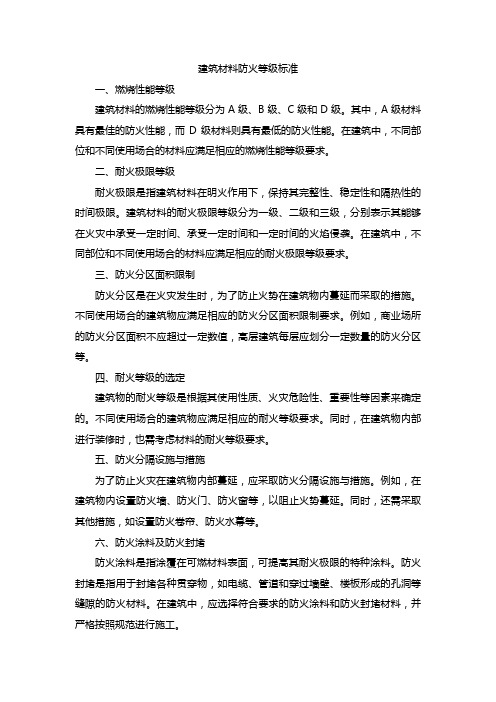
建筑材料防火等级标准一、燃烧性能等级建筑材料的燃烧性能等级分为A级、B级、C级和D级。
其中,A级材料具有最佳的防火性能,而D级材料则具有最低的防火性能。
在建筑中,不同部位和不同使用场合的材料应满足相应的燃烧性能等级要求。
二、耐火极限等级耐火极限是指建筑材料在明火作用下,保持其完整性、稳定性和隔热性的时间极限。
建筑材料的耐火极限等级分为一级、二级和三级,分别表示其能够在火灾中承受一定时间、承受一定时间和一定时间的火焰侵袭。
在建筑中,不同部位和不同使用场合的材料应满足相应的耐火极限等级要求。
三、防火分区面积限制防火分区是在火灾发生时,为了防止火势在建筑物内蔓延而采取的措施。
不同使用场合的建筑物应满足相应的防火分区面积限制要求。
例如,商业场所的防火分区面积不应超过一定数值,高层建筑每层应划分一定数量的防火分区等。
四、耐火等级的选定建筑物的耐火等级是根据其使用性质、火灾危险性、重要性等因素来确定的。
不同使用场合的建筑物应满足相应的耐火等级要求。
同时,在建筑物内部进行装修时,也需考虑材料的耐火等级要求。
五、防火分隔设施与措施为了防止火灾在建筑物内部蔓延,应采取防火分隔设施与措施。
例如,在建筑物内设置防火墙、防火门、防火窗等,以阻止火势蔓延。
同时,还需采取其他措施,如设置防火卷帘、防火水幕等。
六、防火涂料及防火封堵防火涂料是指涂覆在可燃材料表面,可提高其耐火极限的特种涂料。
防火封堵是指用于封堵各种贯穿物,如电缆、管道和穿过墙壁、楼板形成的孔洞等缝隙的防火材料。
在建筑中,应选择符合要求的防火涂料和防火封堵材料,并严格按照规范进行施工。
七、防火门窗及通风排烟防火门窗是指在一定时间内能满足耐火稳定性、完整性和隔热性要求的门和窗。
通风排烟设施是指在火灾发生时,能够将烟气排出室外,以保障人员疏散和灭火救援的顺利进行。
在建筑中,应选择符合要求的防火门窗和通风排烟设施,并严格按照规范进行安装和使用。
八、火灾报警与灭火系统火灾报警系统是指通过探测装置感知火灾发生时产生的烟雾、高温和火焰等信号,并将其转换成电信号输入到报警控制器中,以发出警报并显示火灾位置的系统。
各国建筑材料防火测试标准2012
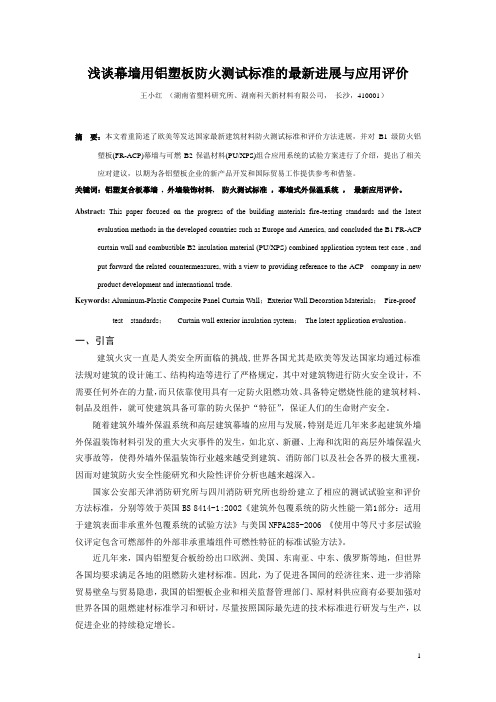
浅谈幕墙用铝塑板防火测试标准的最新进展与应用评价王小红(湖南省塑料研究所、湖南科天新材料有限公司,长沙,410001)摘要:本文着重简述了欧美等发达国家最新建筑材料防火测试标准和评价方法进展,并对B1级防火铝塑板(FR-ACP)幕墙与可燃B2保温材料(PU/XPS)组合应用系统的试验方案进行了介绍,提出了相关应对建议,以期为各铝塑板企业的新产品开发和国际贸易工作提供参考和借鉴。
关键词:铝塑复合板幕墙, 外墙装饰材料, 防火测试标准,幕墙式外保温系统,最新应用评价。
Abstract: This paper focused on the progress of the building materials fire-testing standards and the latest evaluation methods in the developed countries such as Europe and America, and concluded the B1 FR-ACP curtain wall and combustible B2 insulation material (PU/XPS) combined application system test case , and put forward the related countermeasures, with a view to providing reference to the ACP company in new product development and international trade.Keywords: Aluminum-Plastic Composite Panel Curtain Wall;Exterior Wall Decoration Materials;Fire-proof test standards;Curtain wall exterior insulation system;The latest application evaluation。
din4102标准
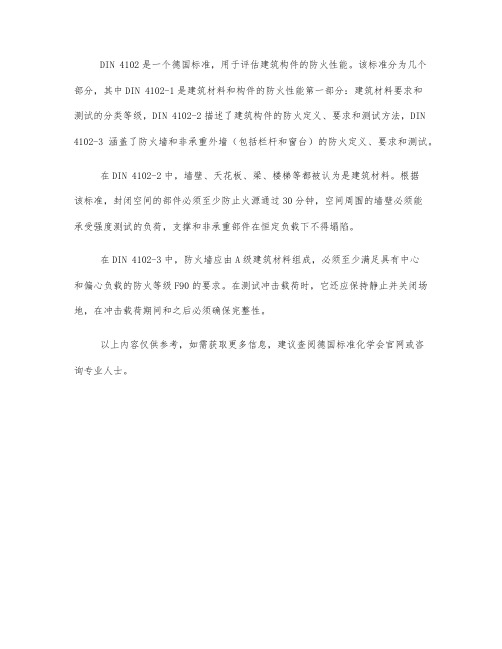
DIN 4102是一个德国标准,用于评估建筑构件的防火性能。
该标准分为几个部分,其中DIN 4102-1是建筑材料和构件的防火性能第一部分:建筑材料要求和
测试的分类等级,DIN 4102-2描述了建筑构件的防火定义、要求和测试方法,DIN 4102-3涵盖了防火墙和非承重外墙(包括栏杆和窗台)的防火定义、要求和测试。
在DIN 4102-2中,墙壁、天花板、梁、楼梯等都被认为是建筑材料。
根据
该标准,封闭空间的部件必须至少防止火源通过30分钟,空间周围的墙壁必须能
承受强度测试的负荷,支撑和非承重部件在恒定负载下不得塌陷。
在DIN 4102-3中,防火墙应由A级建筑材料组成,必须至少满足具有中心
和偏心负载的防火等级F90的要求。
在测试冲击载荷时,它还应保持静止并关闭场地,在冲击载荷期间和之后必须确保完整性。
以上内容仅供参考,如需获取更多信息,建议查阅德国标准化学会官网或咨
询专业人士。
DIN 4102
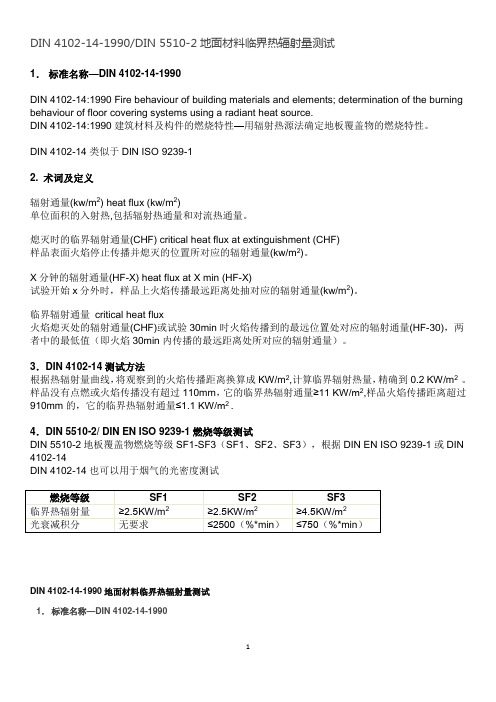
DIN 4102-14-1990/DIN 5510-2地面材料临界热辐射量测试1.标准名称—DIN 4102-14-1990DIN 4102-14:1990 Fire behaviour of building materials and elements; determination of the burning behaviour of floor covering systems using a radiant heat source.DIN 4102-14:1990建筑材料及构件的燃烧特性—用辐射热源法确定地板覆盖物的燃烧特性。
DIN 4102-14类似于DIN ISO 9239-12. 术词及定义辐射通量(kw/m2) heat flux (kw/m2)单位面积的入射热,包括辐射热通量和对流热通量。
熄灭时的临界辐射通量(CHF) critical heat flux at extinguishment (CHF)样品表面火焰停止传播并熄灭的位置所对应的辐射通量(kw/m2)。
X分钟的辐射通量(HF-X) heat flux at X min (HF-X)试验开始x分外时,样品上火焰传播最远距离处抽对应的辐射通量(kw/m2)。
临界辐射通量critical heat flux火焰熄灭处的辐射通量(CHF)或试验30min时火焰传播到的最远位置处对应的辐射通量(HF-30),两者中的最低值(即火焰30min内传播的最远距离处所对应的辐射通量)。
3.DIN 4102-14测试方法根据热辐射量曲线,将观察到的火焰传播距离换算成KW/m2,计算临界辐射热量,精确到0.2 KW/m2 。
样品没有点燃或火焰传播没有超过110mm,它的临界热辐射通量≥11 KW/m2,样品火焰传播距离超过910mm的,它的临界热辐射通量≤1.1 KW/m2 .4.DIN 5510-2/ DIN EN ISO 9239-1燃烧等级测试DIN 5510-2地板覆盖物燃烧等级SF1-SF3(SF1、SF2、SF3),根据DIN EN ISO 9239-1或DIN 4102-14DIN 4102-14也可以用于烟气的光密度测试DIN 4102-14-1990地面材料临界热辐射量测试1.标准名称—DIN 4102-14-1990DIN 4102-14:1990 Fire behaviour of building materials and elements; determination of the burning behaviour of floor covering systems using a radiant heat source.DIN 4102-14:1990建筑材料及构件的燃烧特性—用辐射热源法确定地板覆盖物的燃烧特性。
b1阻燃标准

b1阻燃标准B1阻燃标准是欧洲防火建筑材料的一项标准,也被认为是世界上最具严格要求的阻燃标准之一。
B1级别的防火材料是指阻燃性能达到德国DIN4102-B1标准的材料。
一、B1阻燃标准的定义B1阻燃标准是指建筑材料经过一系列严格的实验,达到一定的防火性能,如具有抗火燃烧性、不易燃、难燃、防火等级符合等标准,即为B1级别的阻燃材料。
1. DIN4102阻燃等级分类DIN4102-B1标准是指建筑材料的防火等级符合欧洲标准分级。
该标准要求材料在火灾发生时,能够自熄或停止燃烧,或维持极低的火焰速度,达到防止火势蔓延的目的。
具体测试方法为:将材料浸泡在标准的化学试剂中,然后将其置于高温炉中进行燃烧测试,测试其防火等级是否符合B1级别标准。
B1级别的阻燃材料主要应用于建筑、航空、汽车、电气设备、化工等领域。
在建筑领域,B1级别的阻燃材料主要应用于防火门、防火涂料、防火隔板、防火板等建筑材料中。
1.较高的阻燃性能B1阻燃材料具有较高的阻燃性能,能够有效防止火灾的发生和蔓延,降低火灾带来的损失。
2.较好的环保性能B1阻燃材料采用环保材料进行生产制造,对环境没有污染和危害。
3.长寿命B1阻燃材料具有长久的使用寿命,能够在长期使用中保持稳定的阻燃性能和机械性能。
五、总结B1阻燃标准是欧洲防火建筑材料的一项标准,也是世界上最具严格要求的阻燃标准之一。
B1级别的阻燃材料具有较高的阻燃性能、较好的环保性能和长寿命等优点,广泛应用于建筑、航空、汽车、电气设备、化工等领域,对防止火灾的发生和蔓延发挥着重要作用。
六、B1阻燃标准的挑战和发展为了解决这些问题,B1阻燃标准的发展需要不断创新和完善。
目前,一些厂商和科研机构正在着手开发更高级别的防火材料,如B1+、B2+等。
这些新材料具有更为优异的防火性能,能够满足特定的防火要求。
加强产品质量监管,提高生产标准、加强质检等举措也能够有效保证B1阻燃材料的质量和防火效果。
七、建筑安全的重要性建筑安全是人们生命和财产安全的基础。
建筑材料燃烧性能分为几
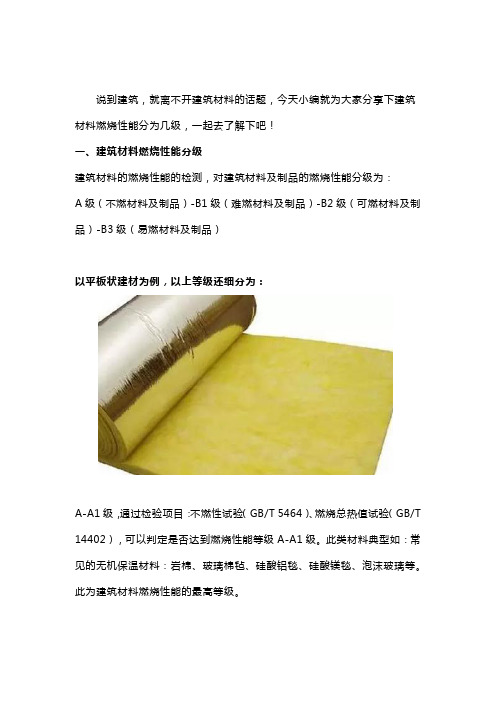
说到建筑,就离不开建筑材料的话题,今天小编就为大家分享下建筑材料燃烧性能分为几级,一起去了解下吧!一、建筑材料燃烧性能分级建筑材料的燃烧性能的检测,对建筑材料及制品的燃烧性能分级为:A级(不燃材料及制品)-B1级(难燃材料及制品)-B2级(可燃材料及制品)-B3级(易燃材料及制品)以平板状建材为例,以上等级还细分为:A-A1级,通过检验项目:不燃性试验(GB/T 5464)、燃烧总热值试验(GB/T 14402),可以判定是否达到燃烧性能等级A-A1级。
此类材料典型如:常见的无机保温材料:岩棉、玻璃棉毡、硅酸铝毯、硅酸镁毯、泡沫玻璃等。
此为建筑材料燃烧性能的最高等级。
A-A2级,通过检验项目:不燃性试验(GB/T 5464)(或燃烧总热值试验(GB/T 14402))、单体燃烧试验(GB/T 20284),可以判定是否达到燃烧性能等级A-A2级。
此类材料典型如:覆贴面的岩棉板、覆贴面的玻璃棉毡、玻璃棉板、气凝胶毡等。
此等级建筑材料制品需附加“烟气毒性等级”,即通过“小白鼠染毒试验”(GB/T 20285)进行的分级。
B1-B级和B1-C级,通过检验项目:单体燃烧试验(GB/T 20284)、可燃性试验(GB/T 8626),可以判定是否达到燃烧性能等级B1-B和B1-C级。
此等级建筑材料制品需附加“烟气毒性等级”,即通过“小白鼠染毒试验”(GB/T 20285)进行的分级。
B2-D级,检验项目同B1级,为单体燃烧试验和可燃性试验。
B2-E级,检验项目为可燃性试验(GB/T 8626),此类材料为可燃材料。
常见的B1和B2级材料主要有:有机类保温材料(聚氨酯PU、聚异氰脲酸酯PIR、挤塑板XPS、模塑板EPS、片状模塑复合材料(SMC)、贴面制品(JC/T 2028)等。
需要注意的是,以上例证仅为经验之谈。
因为材料组成结构、生产工艺的不同,即便是同种材料,其防火性能也会有所不同,如材料中不同种类和数量的阻燃剂的使用、材料表面是否覆有贴面等情况,都会影响其防火性能。
PC塑料板DIN 4102-1 Class B1防火测试
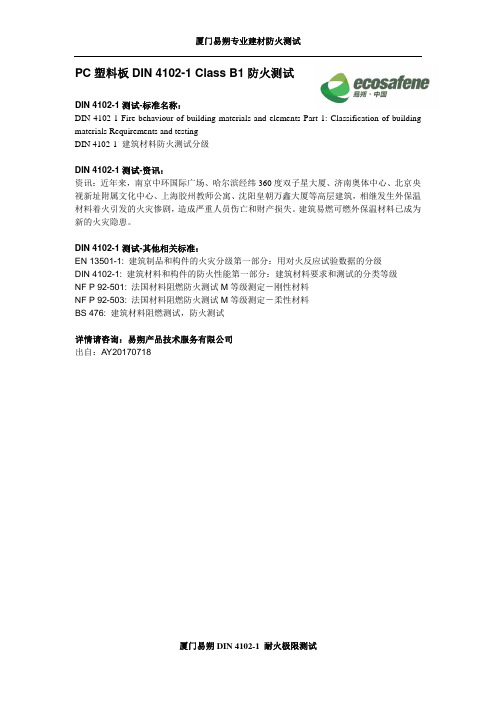
厦门易朔专业建材防火测试
厦门易朔DIN 4102-1 耐火极限测试
PC 塑料板DIN 4102-1 Class B1防火测试
DIN 4102-1测试-标准名称:
DIN 4102-1 Fire behaviour of building materials and elements Part 1: Classification of building materials Requirements and testing
DIN 4102-1 建筑材料防火测试分级
DIN 4102-1测试-资讯:
资讯:近年来,南京中环国际广场、哈尔滨经纬360度双子星大厦、济南奥体中心、北京央视新址附属文化中心、上海胶州教师公寓、沈阳皇朝万鑫大厦等高层建筑,相继发生外保温材料着火引发的火灾惨剧,造成严重人员伤亡和财产损失。
建筑易燃可燃外保温材料已成为新的火灾隐患。
DIN 4102-1测试-其他相关标准:
EN 13501-1: 建筑制品和构件的火灾分级第一部分:用对火反应试验数据的分级 DIN 4102-1: 建筑材料和构件的防火性能第一部分:建筑材料要求和测试的分类等级 NF P 92-501: 法国材料阻燃防火测试M 等级测定-刚性材料
NF P 92-503: 法国材料阻燃防火测试M 等级测定-柔性材料
BS 476: 建筑材料阻燃测试,防火测试
详情请咨询:易朔产品技术服务有限公司
出自:AY20170718。
装饰材料防火等级
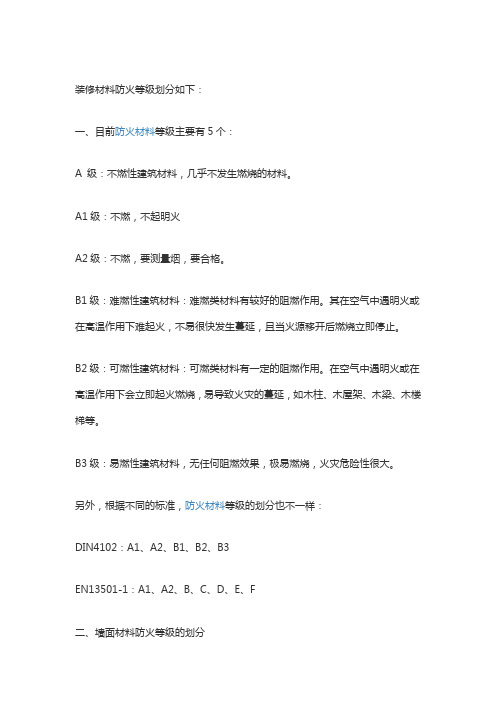
装修材料防火等级划分如下:一、目前防火材料等级主要有5个:A 级:不燃性建筑材料,几乎不发生燃烧的材料。
A1级:不燃,不起明火A2级:不燃,要测量烟,要合格。
B1级:难燃性建筑材料:难燃类材料有较好的阻燃作用。
其在空气中遇明火或在高温作用下难起火,不易很快发生蔓延,且当火源移开后燃烧立即停止。
B2级:可燃性建筑材料:可燃类材料有一定的阻燃作用。
在空气中遇明火或在高温作用下会立即起火燃烧,易导致火灾的蔓延,如木柱、木屋架、木梁、木楼梯等。
B3级:易燃性建筑材料,无任何阻燃效果,极易燃烧,火灾危险性很大。
另外,根据不同的标准,防火材料等级的划分也不一样:DIN4102:A1、A2、B1、B2、B3EN13501-1:A1、A2、B、C、D、E、F二、墙面材料防火等级的划分B1:纸面石膏板、纤维石膏板、水泥刨花板、矿棉板、玻璃棉板、珍珠岩板、难燃胶合板、难燃中密度纤维板、防火塑料装饰板、难燃双面刨花板、多彩涂料、难燃墙纸、难燃墙布、难燃仿花岗岩装饰板、氯氧镁水泥经装配式墙板、难燃玻璃钢平板、PVC塑料护墙板、轻质高强复合墙板、阻燃模压木质复合板材、彩色阻燃人造板、难燃玻璃钢等。
B2 :各类天然木材、木制人造板、竹材、纸制装饰板、装饰微薄木贴面板、印刷木纹人造板、塑料贴面装饰板、聚脂装饰板、复塑装饰板、塑纤板、胶合板、塑料壁纸、无纺贴墙布、墙布、复合壁纸、天然材料壁纸、人造革等三、地面材料防火等级的划分B1:硬PVC塑料地板,水泥刨花板、水泥木丝板、氯丁橡胶地板等B2:半硬质PVC塑料地板、PVC卷材地板、木地板氯纶地毯等四、顶棚材料防火等级的划分B1:纸面石膏板、纤维石膏板、水泥刨花板、矿棉装饰吸声板、玻璃棉装饰吸声板、珍珠岩装饰吸声板、难燃胶合板难燃中密度纤维板、岩棉装饰板、难燃木材、铝箔复合材料、难燃酚醛胶合板、铝箔玻璃钢复合材料等。
五、装饰织物防火等级的划分B1:经阻燃处理的各类难燃织物等B2:纯毛装饰布、纯麻装饰布、经阻燃处理的其他织物等六、其他装饰材料等级的划分B1:聚氯乙烯塑料、酚醛塑料、聚碳酸酯塑料、聚四氟乙烯塑料、三氯氰胺、脲醛塑料、硅树脂塑料装饰型材、经阻烯处理的各类织物等。
国际上通用的材料的防火等级划分

一、概述随着现代建筑技术的发展,人们对建筑材料的防火性能提出了更高的要求。
在国际上,为了统一材料的防火等级划分,制定了一系列标准和规定。
本文将就国际上通用的材料的防火等级划分进行介绍和分析。
二、国际通用的防火等级划分标准1. 欧洲标准在欧洲,建筑材料的防火等级划分主要依据ENxxx标准。
该标准将材料分为不燃性材料、有限燃烧材料、可燃性材料三个等级,并根据火灾的燃烧性能、烟雾产生、滴落情况进行详细的区分和标注。
2. 美国标准美国对建筑材料的防火等级划分依据NFPA 101标准。
该标准将建筑材料分为类A、类B、类C三个等级,并根据材料的燃烧性能、烟雾排放量、毒气产生量进行评定。
3. 我国标准我国对建筑材料的防火等级划分主要依据GB8624标准。
该标准将材料分为不燃材料、难燃材料、普通材料三个等级,并根据燃烧性能、烟雾产生情况进行细致的标注。
三、国际通用的防火等级划分对建筑安全的意义1. 保障建筑物的安全国际通用的防火等级划分标准的实施,可以有效地保障建筑物的安全。
通过对建筑材料的防火性能进行严格的划分,可以减少建筑物在火灾发生时的燃烧情况,降低火灾对人员和财产造成的损失。
2. 促进建筑技术的进步国际通用的防火等级划分标准的制定,促进了建筑技术的发展。
建筑材料在满足防火等级要求的也需要兼顾其他性能,如抗压强度、耐磨性等,这促进了材料科学和技术的不断进步。
3. 促进国际建筑材料的交流与合作国际通用的防火等级划分标准的统一,促进了国际建筑材料的交流与合作。
通过统一的标准,不同国家的建筑材料可以更加便利地在国际市场上流通和应用,促进了国际建筑材料行业的合作与发展。
四、国际通用的防火等级划分的不足之处1. 标准差异虽然国际上制定了一系列的标准和规定,但不同国家的标准仍存在一定的差异。
这导致了建筑材料在不同国家之间的防火等级划分存在一定的障碍,对国际建筑材料的流通和应用造成了一定的影响。
2. 标准落实在一些国家,由于相关监管和标准制定机构的不完善,国际通用的防火等级划分标准的落实并不到位。
建筑材料防火等级
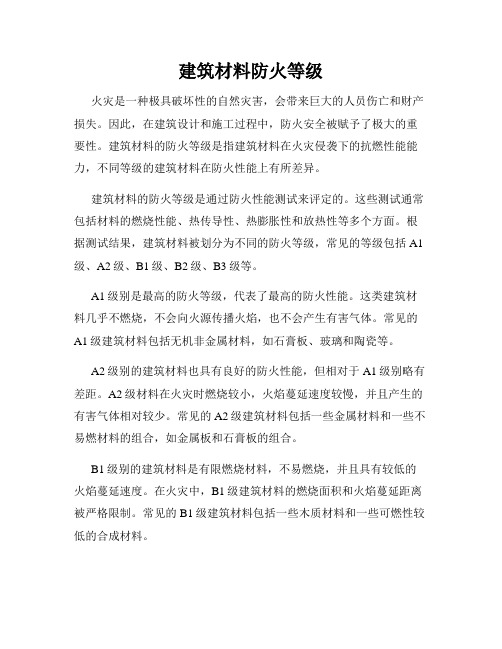
建筑材料防火等级火灾是一种极具破坏性的自然灾害,会带来巨大的人员伤亡和财产损失。
因此,在建筑设计和施工过程中,防火安全被赋予了极大的重要性。
建筑材料的防火等级是指建筑材料在火灾侵袭下的抗燃性能能力,不同等级的建筑材料在防火性能上有所差异。
建筑材料的防火等级是通过防火性能测试来评定的。
这些测试通常包括材料的燃烧性能、热传导性、热膨胀性和放热性等多个方面。
根据测试结果,建筑材料被划分为不同的防火等级,常见的等级包括A1级、A2级、B1级、B2级、B3级等。
A1级别是最高的防火等级,代表了最高的防火性能。
这类建筑材料几乎不燃烧,不会向火源传播火焰,也不会产生有害气体。
常见的A1级建筑材料包括无机非金属材料,如石膏板、玻璃和陶瓷等。
A2级别的建筑材料也具有良好的防火性能,但相对于A1级别略有差距。
A2级材料在火灾时燃烧较小,火焰蔓延速度较慢,并且产生的有害气体相对较少。
常见的A2级建筑材料包括一些金属材料和一些不易燃材料的组合,如金属板和石膏板的组合。
B1级别的建筑材料是有限燃烧材料,不易燃烧,并且具有较低的火焰蔓延速度。
在火灾中,B1级建筑材料的燃烧面积和火焰蔓延距离被严格限制。
常见的B1级建筑材料包括一些木质材料和一些可燃性较低的合成材料。
B2级别的建筑材料燃烧性较大,火焰蔓延速度较快,但燃烧程度相对较小。
在火灾中,B2级建筑材料的燃烧面积和火焰蔓延距离也有一定限制。
常见的B2级建筑材料包括一些较普通的合成材料,如聚乙烯和聚氯乙烯等。
B3级别的建筑材料燃烧性最大,火焰蔓延速度最快。
在火灾中,B3级建筑材料的燃烧面积和火焰蔓延距离的限制较为宽松。
常见的B3级建筑材料包括一些可燃性较高的合成材料,如聚苯乙烯和聚氨酯等。
了解建筑材料的防火等级对于保障建筑的防火安全至关重要。
在建筑设计和施工中,选择适当的防火等级的建筑材料能够有效地减少火灾的发生和蔓延。
同时,建筑材料的防火等级也受到不同国家和地区法律法规的要求和规定,因此需要在项目中遵守相关的法律法规,确保建筑的防火安全性。
建筑材料及制品燃烧性能分级
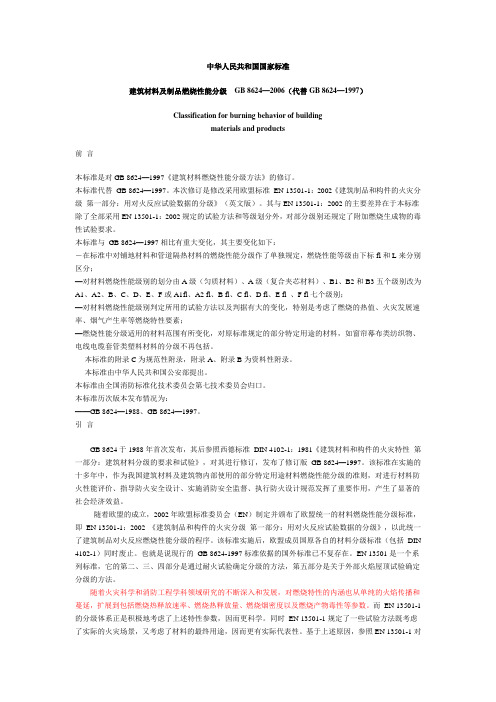
中华人民共和国国家标准建筑材料及制品燃烧性能分级GB 8624—2006(代替GB 8624—1997)Classification for burning behavior of buildingmaterials and products前言本标准是对GB 8624—1997《建筑材料燃烧性能分级方法》的修订。
本标准代替GB 8624—1997。
本次修订是修改采用欧盟标准EN 13501-1:2002《建筑制品和构件的火灾分级第一部分:用对火反应试验数据的分级》(英文版)。
其与EN 13501-1:2002的主要差异在于本标准除了全部采用EN 13501-1:2002规定的试验方法和等级划分外,对部分级别还规定了附加燃烧生成物的毒性试验要求。
本标准与GB 8624—1997相比有重大变化,其主要变化如下:-在标准中对铺地材料和管道隔热材料的燃烧性能分级作了单独规定,燃烧性能等级由下标fl和L来分别区分;—对材料燃烧性能级别的划分由A级(匀质材料)、A级(复合夹芯材料)、B1、B2和B3五个级别改为A1、A2、B、C、D、E、F或A1fl、A2 fl、B fl、C fl、D fl、E fl 、F fl七个级别;—对材料燃烧性能级别判定所用的试验方法以及判据有大的变化,特别是考虑了燃烧的热值、火灾发展速率、烟气产生率等燃烧特性要素;—燃烧性能分级适用的材料范围有所变化,对原标准规定的部分特定用途的材料,如窗帘幕布类纺织物、电线电缆套管类塑料材料的分级不再包括。
本标准的附录C为规范性附录,附录A、附录B为资料性附录。
本标准由中华人民共和国公安部提出。
本标准由全国消防标准化技术委员会第七技术委员会归口。
本标准历次版本发布情况为:——GB 8624—1988、GB 8624—1997。
引言GB 8624于1988年首次发布,其后参照西德标准DIN 4102-1:1981《建筑材料和构件的火灾特性第一部分:建筑材料分级的要求和试验》,对其进行修订,发布了修订版GB 8624—1997。
建筑材料燃烧性能分级方法
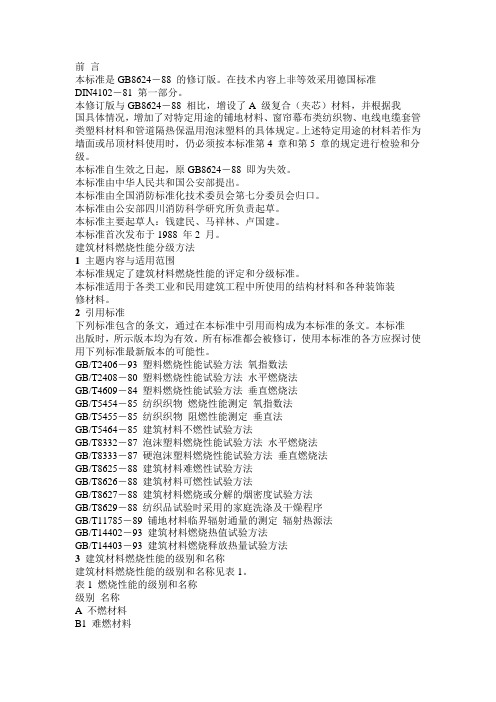
前言本标准是GB8624-88 的修订版。
在技术内容上非等效采用德国标准DIN4102-81 第一部分。
本修订版与GB8624-88 相比,增设了A 级复合(夹芯)材料,并根据我国具体情况,增加了对特定用途的铺地材料、窗帘幕布类纺织物、电线电缆套管类塑料材料和管道隔热保温用泡沫塑料的具体规定。
上述特定用途的材料若作为墙面或吊顶材料使用时,仍必须按本标准第4 章和第5 章的规定进行检验和分级。
本标准自生效之日起,原GB8624-88 即为失效。
本标准由中华人民共和国公安部提出。
本标准由全国消防标准化技术委员会第七分委员会归口。
本标准由公安部四川消防科学研究所负责起草。
本标准主要起草人:钱建民、马祥林、卢国建。
本标准首次发布于1988 年2 月。
建筑材料燃烧性能分级方法1 主题内容与适用范围本标准规定了建筑材料燃烧性能的评定和分级标准。
本标准适用于各类工业和民用建筑工程中所使用的结构材料和各种装饰装修材料。
2 引用标准下列标准包含的条文,通过在本标准中引用而构成为本标准的条文。
本标准出版时,所示版本均为有效。
所有标准都会被修订,使用本标准的各方应探讨使用下列标准最新版本的可能性。
GB/T2406-93 塑料燃烧性能试验方法氧指数法GB/T2408-80 塑料燃烧性能试验方法水平燃烧法GB/T4609-84 塑料燃烧性能试验方法垂直燃烧法GB/T5454-85 纺织织物燃烧性能测定氧指数法GB/T5455-85 纺织织物阻燃性能测定垂直法GB/T5464-85 建筑材料不燃性试验方法GB/T8332-87 泡沫塑料燃烧性能试验方法水平燃烧法GB/T8333-87 硬泡沫塑料燃烧性能试验方法垂直燃烧法GB/T8625-88 建筑材料难燃性试验方法GB/T8626-88 建筑材料可燃性试验方法GB/T8627-88 建筑材料燃烧或分解的烟密度试验方法GB/T8629-88 纺织品试验时采用的家庭洗涤及干燥程序GB/T11785-89 铺地材料临界辐射通量的测定辐射热源法GB/T14402-93 建筑材料燃烧热值试验方法GB/T14403-93 建筑材料燃烧释放热量试验方法3 建筑材料燃烧性能的级别和名称建筑材料燃烧性能的级别和名称见表1。
- 1、下载文档前请自行甄别文档内容的完整性,平台不提供额外的编辑、内容补充、找答案等附加服务。
- 2、"仅部分预览"的文档,不可在线预览部分如存在完整性等问题,可反馈申请退款(可完整预览的文档不适用该条件!)。
- 3、如文档侵犯您的权益,请联系客服反馈,我们会尽快为您处理(人工客服工作时间:9:00-18:30)。
6DIN 4102-1 参照标准
DIN 4102-2/4/8/14/15/16: 建筑材料和构件的防火性能 DIN 18180: 石膏板 – 类型, 要求和测试 DIN 50014: 气候及技术应用 – 标准大气 DIN 50050-1: 材料燃烧性能测试-小型燃烧箱 DIN 50051: 材料燃烧性能测试-燃烧器 DIN 50055: 烟雾弥散性试验用的光测量系统 DIN 51622: 液化石油气.丙烷、丙烯、丁烷、丁烯及其混合物.要求 DIN 51900-2: 固体和液体燃料检验.用弹式量热器测定总热值和计算净热值. DIN 53436-1/2/3: 消防污水毒性测试 DIN 53438-1: 可燃材料的检验.对用小火焰点火的反应-一般数据 DIN 66081: 纺织品燃烧性能分级 – 防止地面材料 IS0 1716: 1973: 建筑材料 - 潜在热量测定
DIN4102-1
目录
1DIN4102-1 标准名称 2DIN4102-1 标准概述 3DIN4102-1 适用范围 4DIN4102-1 测试要求 5DIN4102-1 测试方法 6DIN4102-1 参照标准 1DIN 4102-1 标准名称
DIN4102-1:建筑材料和构件的防火性能 第 1 部分:建筑材料要求和测试的分类等级 DIN4102-1 Fire behaviour of building materials and elements Part 1: Classification of building materials Requirements and testing
2DIN 4102-1 标准概述
DIN4102-1 标准详细说明了建筑材料燃烧性能等级,以及每个等级的
所适用部分建筑材料如下(包含但不限于此):
板材/片材
装饰材料
阻燃剂
复合材料
门帘/窗帘
发泡性防火涂料
组装材料
天花板悬挂材料 管道及配件
表面覆盖材料 绝缘保温材料
涂料
4DIN 4102-1 测试要求
当材料的火灾行为符合该标准确定的特征时,分为:
- 符合 A2 要求
A1
- 根据标准进行不燃性测试
不燃材料 - 根据标准进行燃烧总热值测试
- 燃烧烟雾产生测试
A2 不燃材料
- 根据 DIN 4102-16 进行测试 - 根据标准进行不燃性测试或者燃烧总热值测试 - 燃烧烟雾产生测试
B1
- 测试符合 B2 要求
难燃材料
B2 可燃材料 B3 易燃材料
- 剩余样品长度大于 15cm - 温度不超过 200 度 - 火焰 20s 后延伸到标线 - 纸没有燃烧 - 滴落燃烧在 2s 内
- 没能符合 B2 等级
5DIN 4102-1 测试方法
A1 级: 对于 A1 测试,要求将样品垂直放置在 750℃的电炉内,另外施加 20MM 的火焰,试验时间为 15~30MIN,如果样品满足以下条件则认为达到 A1 要求:无明燃(明燃要求另有规定);炉内温 升小于 50℃;已经满足 A2 要求。 A2 级: A2 试验方法采用 Brandschacht 方法进行,采用垂直距阵燃烧,点燃源为环状喷灯,试验时间为 10MIN。能够达到 A2 等级的材料必须满足:样品平均剩余长度不小于 350MM,其中任一样品的剩 余长度不小于 200MM;平均烟气温度不超过 125℃;任一样品的背面不燃;无其他意外事情。另 外,烟密度按照 ASTM D 2843(XP2 烟箱)和 DIN E 53436/37 测试,热分解毒性产物按照 DIN 53436.1~3 测定,潜热按 DIN 51900.2 测定,释热按照 DIN 4102.8C 测定。 B1 级: 仍采用 Brandschacht 方法,测试方法与 A2 一样,评判要求包括:平均剩余长度不小于 150MM,任何 一个样品的剩余长度不能为 0;平均烟气温度不超过 220℃;不存在其他意外情况。 B2 级: 系采用小喷灯试验法。对于均质材料则可采用边缘点火或表面点火,火焰焰高 20MM,45 度角点 燃,施火时间为 15S,试验 20S。在 20S 内,如果火焰顶部没有达到,则通过试验,如果边缘有 保护的要加做表面点燃测试,另外如果熔滴点燃下端滤纸则不通过。非均质材料则要提供纵横 向样品分别测试。 B3 级: 不能达到 B2 标准的即划为 B3。
